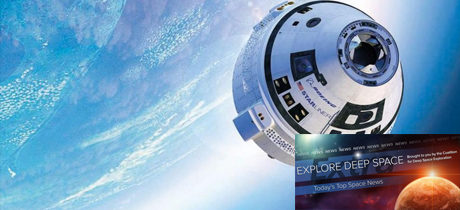In Today’s Deep Space Extra… U.S. and European astronauts set out early Friday on the first in a series of complex spacewalks to upgrade a cosmic ray observatory on the outside of the International Space Station (ISS). NASA’s inspector general issued an audit of the agency’s Commercial Crew Program on Thursday that outlines challenges Boeing and SpaceX face in completing work on two spacecraft to transport astronauts to and from the ISS and other low Earth orbit destinations. Vice President Mike Pence paid tribute Thursday to the Apollo 12 crew and those at NASA who achieved the second human Moon landing on November 19, 1969.
Human Space Exploration
Astronauts will take four of the most challenging spacewalks ever to fix a dark matter experiment
Space.com (11/14): European Space Agency (ESA) astronaut Luca Parmitano and NASA astronaut Drew Morgan prepared to emerge from the airlock of the International Space Station (ISS) early Friday to initiate a series of four or more complex spacewalks to overhaul the thermal control system of the Alpha Magnetic Spectrometer (AMS). The AMS was launched in May 2011 as a cosmic ray observatory designed to seek out anti matter and dark matter. It is also helping to characterize the radiation environment for future human deep space explorers. A sequence of failures have reduced the number of functional cooling pumps on the AMS from four to one. The AMS was not designed for repairs and initially not intended to function for more than three years. The first spacewalk, which was to get underway shortly after 7 a.m., EST, is to remove protective outer shielding, exposing cooling lines, data and power cables that must be spliced, disconnected and reconnected on future spacewalks to install a new cooling pump assembly.
‘Artemis is here:’ Vice President Pence stresses importance of 2024 Moon landing
Space.com (11/14): Mike Pence, the U.S. Vice President and chair of the White House National Space Council, visited and spoke from NASA’s Ames Research Center in Mountain View, California, on Thursday. Pence paid tribute to those with NASA who launched Apollo 12, the second human Moon landing, a half century ago. He praised NASA Administrator Jim Bridenstine and said he is committed to ensuring the space agency has the resources needed to accelerate a human return to the Moon in 2024.
Senate committee approves NASA authorization bill
SpaceNews.com (11/13): The U.S. Senate Commerce Committee earlier this week adopted the NASA Authorization Act of 2020, which was introduced a week earlier and amended by panel members. The measure calls for an extension of NASA oversight of the International Space Station (ISS) from 2024 until 2030 and a stepping stone approach for human deep exploration that heads for the Moon, then Mars and without explicitly setting 2024 for the lunar return as called for by the White House. The bill, sponsored by U.S. Sen. Ted Cruz, chair of the Senate Space Subcommittee, now goes to the full Senate. Cruz urged U.S. House colleagues to embrace the measure as well.
NASA Inspector General criticizes additional Boeing commercial crew payments
Coalition Member in the News – Boeing
SpaceNews.com (11/14): NASA’s Commercial Crew Program is partnered with Boeing and SpaceX for the development of two commercial means of transporting astronauts to and from the International Space Station (ISS) in the wake of the space shuttle program’s retirement in 2011. A new audit from NASA’s Inspector General questions payments totaling nearly $300 million made by NASA to Boeing to keep the company from dropping out of the technically and budget challenged initiative. Both companies are preparing for milestone test flights in order to achieve NASA certifications to begin scheduled launches in of the CST-100 Starliner and Crew Dragon in 2020. The audit cautions additional delays in the technically and cost challenged effort will mean a major restriction in the number of U.S. crew members assigned to the ISS in 2020, leading to cutback in scientific research and technology demonstrations.
Space Science
Molecular oxygen on Mars is behaving unusually through the seasons. A sign of life?
Universe Today (11/14): NASA’s Curiosity rover has been investigating the habitability of Gale Crater since touching down in August 2012. Recently, the rover has detected puzzling variations in concentrations of methane that seem to be seasonally driven in the thin Martian atmosphere, and now variations in oxygen. The oxygen variation, however, does not appear linked to seasonal changes. Scientists wonder if the variations could be linked to biological activity.
A black hole threw a star out of the Milky Way galaxy
New York Times (11/14): The massive black hole at the center of the Milky Way galaxy has been observed by astronomers “kicking” a star designated S5-HVS1 speeding away at a velocity of 4 million miles per hour. The star is 29,000 light years from Earth.
Other News
Could Kennedy Space Center (KSC) launch pads be at risk as climate changes? Experts say yes
Florida Today (11/14): Climate change could pose a threat to launch complexes on Florida’s Space Coast, NASA’s Kennedy Space Center (KSC) and Cape Canaveral Air Force Station, from coastal flooding. Authorities are building a coastal dune, the question is will that be enough, according to local authorities. Sea levels are forecast to rise 5 to 8 inches by 2050 due to a warming climate. But with significant melting of the polar ice caps, the levels could rise 17 to 24 inches, according to estimates.
China completes crucial landing test for first Mars mission in 2020
Reuters via New York Times (11/14): The hovering and obstacle avoidance test on Thursday was for the lander China intends to launch to Mars in 2020. NASA and the European and Russian space agencies are going to the Red Planet with rovers and landers next year as well.

